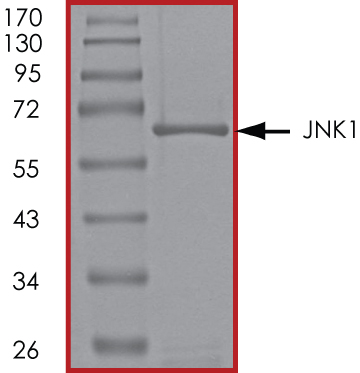Recombinant Mouse Active JNK1 Protein, CF Summary
Product Specifications
Analysis
Product Datasheets
Carrier Free
CF stands for Carrier Free (CF). We typically add Bovine Serum Albumin (BSA) as a carrier protein to our recombinant proteins. Adding a carrier protein enhances protein stability, increases shelf-life, and allows the recombinant protein to be stored at a more dilute concentration. The carrier free version does not contain BSA.
In general, we advise purchasing the recombinant protein with BSA for use in cell or tissue culture, or as an ELISA standard. In contrast, the carrier free protein is recommended for applications, in which the presence of BSA could interfere.
1776-KS
| Formulation | Supplied in 50 mM Tris-HCl, pH 7.5, 150 mM NaCl, 10 mM Glutathione, 0.25 mM DTT, 0.1 mM EDTA, 0.1 mM PMSF, 25% glycerol. |
| Shipping | The product is shipped with dry ice or equivalent. Upon receipt, store it immediately at the temperature recommended below. |
| Stability & Storage: | This product is stable at ≤ ‑70°C for up to 1 year from the date of receipt. For optimal storage, aliquot into smaller quantities after centrifugation and store at recommended temperature. Avoid repeated freeze-thaw cycles. |
Assay Procedure
- Active Kinase - Active JNK1 (0.1 μg/μL) diluted with Kinase Dilution Buffer IX and assayed as outlined in sample activity plot. Note: These are suggested working dilutions. Optimal dilutions should be determined by each laboratory for each application.
- Kinase Assay Buffer III (5X) - 200 mM Tris-HCl, pH 7.4, 100 mM MgCl2, and 0.5 mg/mL BSA. Add fresh DTT prior to use to a final concentration of 250 μM.
- Kinase Dilution Buffer IX (1X) - Kinase Assay Buffer III diluted at a 1:4 ratio (5X dilution) with cold, distilled water. Add fresh DTT prior to use to a final concentration of 50 μM.
- ADP-GloTM Kinase Assay Kit - 10 mM of ATP Solution, 10 mM of ADP Solution, ADP-GloTM Reagent, and Kinase Detection Reagent.
- Substrate - ATF2 substrate prepared in buffer (50 mM Tris-HCl, pH 7.5, 150 mM NaCl, 10 mM Glutathione, 0.1 mM EDTA, and 0.25 mM DTT) to a final concentration of 0.2 mg/mL.
- Thaw the Active JNK1, Kinase Assay Buffer III (5X), and Substrate on ice. Prepare a 15 μL enzyme dilution using Kinase Dilution Buffer IX (1X), at the desired concentration, in a pre-chilled 96-well plate.
- Prepare a Substrate/ATP mixture as follows (25 μM example):
a. 10 mM ATP Solution: 1 μL
b. Kinase Assay Buffer III (5X): 79 μL
c. Substrate at 0.2 mg/mL: 80 μL - Transfer the following reaction components prepared in Steps 1 and 2 to a 384-well opaque plate, bringing the reaction volume up to 5 μL:
a. 3 μL of diluted Active JNK1
b. 2 μL of Substrate/ATP mix as prepared in Step 2. This initiates the reaction. - Set up the blank control as outlined in Step 2, excluding the addition of the kinase. Replace the kinase with an equal volume of Kinase Dilution Buffer IX (1X).
- Incubate at ambient temperature for 40 minutes.
- After the 40 minute incubation period, terminate the reaction and deplete the remaining ATP by adding 5 μL of ADP-Glo Reagent. Spin down and shake the 384-well plate. Then incubate the reaction mixture for another 40 minutes at ambient temperature.
- Add 10 μL of the Kinase Detection Reagent to the 384-well plate and incubate the reaction mixture for another 30 minutes at ambient temperature.
- Read the 384-well reaction plate using the Luminescence Module Protocol on a GloMax®-Multi Microplate Multimode Reader.
- Determine the corrected activity (RLU) by removing the blank control value (see step 4) for each sample and calculate the kinase specific activity as outlined below.
Calculation of Specific Activity of ADP (RLU/pmol)
From ATP-ADP conversion vurce, determine RLU/pmol of ADP
Kinase Specific Activity (SA) (pmol/minutes/μg or nmol/minutes/mg)
Corrected RLU from reaction / [(SA of ADP in RLU/pmol) x (Reaction time in minutes) x (Enzyme amount in μg or mg)]
Scientific Data
Reconstitution Calculator
Background: JNK1
JNK1 is a member of the MAP kinase group that is activated by dual phosphorylation on Threonine and Tyrosine residues during exposure to stress such as UV irradiation. JNK1 binds to the c-Jun transactivation domain and phosphorylates it on S63 and S73 (1). JNK1 has been shown to play an important role in disease processes. Activation of JNK1 results in defects in myotube viability and integrity leading to dystrophic myofiber destruction (2). JNK1 activity is also abnormally elevated in obesity and removal of JNK1 results in decreased adiposity and significantly improved insulin sensitivity.
- Derijard, B. et al. (1994) Cell 76:1025.
- Kolodziejczyk, S.M. et al. (2001) Curr. Biol. 11:1278.
Citation for Recombinant Mouse Active JNK1 Protein, CF
R&D Systems personnel manually curate a database that contains references using R&D Systems products. The data collected includes not only links to publications in PubMed, but also provides information about sample types, species, and experimental conditions.
1 Citation: Showing 1 - 1
-
Capture of Dense Core Vesicles at Synapses by JNK-Dependent Phosphorylation of Synaptotagmin-4
Authors: V Bharat, M Siebrecht, K Burk, S Ahmed, C Reissner, M Kohansal-N, V Steubler, M Zweckstett, JT Ting, C Dean
Cell Rep, 2017-11-21;21(8):2118-2133.
Applications: Bioassay
FAQs
No product specific FAQs exist for this product, however you may
View all Proteins and Enzyme FAQsReviews for Recombinant Mouse Active JNK1 Protein, CF
There are currently no reviews for this product. Be the first to review Recombinant Mouse Active JNK1 Protein, CF and earn rewards!
Have you used Recombinant Mouse Active JNK1 Protein, CF?
Submit a review and receive an Amazon gift card.
$25/€18/£15/$25CAN/¥75 Yuan/¥2500 Yen for a review with an image
$10/€7/£6/$10 CAD/¥70 Yuan/¥1110 Yen for a review without an image









